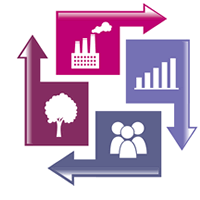“If you don’t know where you are going, any road will get you there.”
Lewis Carroll
What are the cross overs between quality management and sustainability?

In the business world, quality management, often framed as TQM (Total Quality Management) and latterly Lean Manufacturing or Six Sigma, has been around longer than corporate sustainability. It has a different focus than sustainability or environmental management but there are several common areas and objectives – and many of the keys to successful implementation are the same. Best practice in sustainability involves bringing a wider range of factors into consideration than might be conventionally considered as business drivers, using a range of management approaches, including; risk management, stakeholder engagement and TQM.
Best practice sustainability provides organisations with a holistic and integrative approach that moves beyond efficiency and value conservation towards seeing sustainability as a driver of value and innovation.
In their research on large corporations published in Harvard Business Review 2009, Ram Nidumolu, CK Prahalad and MR Rangaswami suggested that sustainability was the “key driver of innovation”. They stated:
“Our research shows that sustainability is a mother lode of organizational and technological innovations that yield both bottom-line and top-line returns. Becoming environment-friendly lowers costs because companies end up reducing the inputs they use. In addition, the process generates additional revenues from better products or enables companies to create new businesses. In fact, because those are the goals of corporate innovation, we find that smart companies now treat sustainability as innovation’s new frontier.”
TQM and sustainability have a number of common aspects:
Active approaches – TQM, EMS (Environmental Management Systems) and best practice sustainability approaches all advocate aspects of continuous improvement of performance over and above monitoring and inspection. In corporate sustainability, the boundary is extended beyond operations to include the whole value chain.
Enablement and empowerment – is key to supply chain sustainability and to ‘quality at source’ approaches in TQM. The key is developing open and fair working conditions and the right culture to empower and enable staff.
Whole-cost approaches – both approaches take a holistic, lifecycle, approach to looking at costs and performance. Critically sustainability looks across the entire value chain including material sourcing, manufacturing, operations, end of life and where and how impacts and benefits arise. This approach helps deliver improved supply chain, operational and product performance.
Collaboration – both disciplines rely upon building functional links vertically and across decisions and departments and for sustainability deep into value chains.
Corporate governance – is key to the success of both quality and sustainability approaches. Causes of problems are best addressed through leadership taking responsibility, making commitments and consistently driving progress.
How might sustainability enhance quality?
In two main ways:
1. Reputation.
Best practice in sustainability management brings several benefits to the enterprise including reducing material use, using less energy and water, increasing a focus on employee wellbeing and development, improving product design and helping solve customers’ problems. It is a holistic and long-term approach to operations and enterprise management. Improving performance in these areas is a powerful element in building, maintaining and enhancing reputation.
2. Product performance.
Pursuing best practice sustainability performance is the pursuit of product performance across the value chain. It can help you pursue the design and manufacture of lower footprint products and deliver products with higher performance characteristics (i.e. longer life, longer mean time between failures [MTBF], lower total cost of ownership [TCO] etc.).
This in turn helps your customers reduce their sustainability impacts and help meet their objectives or those of their own customers.
Refining established practice vs stimulating innovation
If there are a range of parallels between quality and sustainability, are there also differences and divergences of intent and approach?
The answer is of course, that it depends. For some quality management approaches, seeking innovation and identifying different opportunities for value creation is central. For others, it is the refinement and evolution of existing processes which is the goal. To put it simply, the former approach actively courts revolution and the latter is wedded to evolution.
Most approaches to sustainability management focus on evolution, though they often toy with the notion of revolution. Many large company sustainability vision statements talk about the company’s intention to contribute to a changed, sustainable, utopian, future. However, their goals and management effort focusses upon incremental improvements in environmental performance and the minimisation of social and labour risks.
In many cases, the approach such companies use to deliver environmental performance improvements is ISO14001, which frequently struggles to deliver anything other than (at best) more streamlined and mildly less impactful business as usual.
Delivering sustainable change – the strategic challenge
As noted above, there are a number of ways that sustainability and quality management can be seen to have taken parallel pathways and can be managed within formal systems that share a number of principles and approaches. However, there is a larger question for sustainability, to what extent does the current continuous improvement focussed management of sustainability deliver real strategic change?
Until relatively recently, the answer to this was quite short and sweet, it doesn’t.
The major predominant certifiable approach to sustainability management was the Environmental Management System ISO 14001. Conceived to align with the principles and approaches of quality management and sharing its focus upon continuous improvement, ISO 14001 was an operationally focussed management approach. As such it didn’t require that fundamental questions be asked about the purpose of the business and overall impact of the business as a whole, instead just focussing upon the management of operational impacts. This is why you can find companies with ISO14001 in place that you would struggle to consider as either currently or potentially sustainable.
As originally designed, ISO 14001: 1996 was focussed on assisting companies to be less unsustainable versions of themselves. It didn’t ask questions about whether they needed to be fundamentally different if they were to stand a chance of being sustainable. This had the effect that, for many companies, sustainability was seen as an operational efficiency issue, not a question of future-proofing or requiring a reconsideration of purpose or business model.
In order to address this challenge, ISO14001: 2015 was launched. The revised management system included, for the first time, an explicit requirement for the management performance of an organisation with ISO 14001 to be conducted:
- In the competitive, market and sustainability context that the organisation operates within, and;
- With a focus upon ensuring that environmental management is conducted in alignment with overall business strategy (the subject of our work over the past 20 years – see this article on ensuring strategic alignment).
For a quick overview of the changes and differences between ISO14001:2004 and ISO 14001: 2015, see this briefing from the BSI.
Despite the significant focus upon a strategic dimension within ISO 14001: 2015, it still stops short of questioning the current and future environmental viability or overall sustainability of business strategy in the first place. Therefore, it could still be argued that even with such changes, ISO14001: 2015 still falls short of an approach likely to deliver truly sustainable organisations. Rather, it is more likely to support the continuation of business as (broadly) usual.
Questioning purpose – changing the paradigm
If sustainability requires radically different outcomes, then the approach that we need to take to its management would be one that actively questions the status quo and promotes different, revolutionary, approaches to creating business value whilst maintaining and enhancing social and ecological quality.
Ultimately, until we have systems and standards which support the development of truly sustainable business, question organisational purpose and drive rejuvenative enterprise (to make a manifest contribution to the heath and vitality and natural and social systems) we are unlikely to create a sustainable future.
Further perspectives and analysis:
For our thinking on developing a truly strategic sustainability approach, download our guidance, Building Sustainable Strategy.
For exploring the challenges of using standards to deliver transformation, see Looking forward and facing back – can standards deliver a sustainable world?
Exploring the need for businesses to understand their sustainability context: Context and capitals – the next big things in corporate sustainability.
Developing meaningful sustainability performance metrics (white paper): Beyond Profit: Forward looking indicators for sustainability

 Trends in sustainable business 2019
Trends in sustainable business 2019
Leave a Reply